

Compact Muon Solenoid
LHC, CERN
| CMS-PAS-HIN-16-006 | ||
| Splitting function in pp and PbPb collisions at $\sqrt{s_{\mathrm{NN}}}= $ 5.02 TeV | ||
| CMS Collaboration | ||
| July 2016 | ||
| Abstract: A measurement of the splitting function in pp and PbPb collisions at a center of mass energy of 5.02 TeV per nucleon pair is presented. The virtuality evolution of partons traversing the hot QCD medium created in a heavy ion collision is potentially modified due to interactions with the color charges of the medium. This measurement probes this phenomenon by measuring the generalized fragmentation function, or splitting function, over a wide range of jet transverse momentum and various collision centrality selections. The shared momentum fraction of two subjets resulting from a parton splitting is observed to be modified towards a more imbalanced fraction in central PbPb collisions compared to peripheral PbPb and pp collisions. In addition, the measurement in pp collisions is compared to the prediction of the splitting function from the PYTHIA and HERWIG event generators. | ||
|
Links:
CDS record (PDF) ;
inSPIRE record ;
CADI line (restricted) ;
These preliminary results are superseded in this paper, PRL 120 (2018) 142302. The superseded preliminary plots can be found here. |
||
| Figures & Tables | Summary | Additional Figures | References | CMS Publications |
|---|
| Figures | |

png pdf |
Figure 1-a:
Groomed jet energy fraction in pp (a) and 10% most central PbPb collisions (b) for jets with 140 $ < {p_{\mathrm {T,jet}}}< $ 160 GeV and $|\eta _{\mathrm {jet}}|< $ 1.3. The pp data is compared to the PYTHIA event generator and the PbPb data to PYTHIA embedded into the HYDJET event generator. Jets are reconstructed with the anti- ${k_{\mathrm {T}}}$ algorithm and groomed using Softdrop. The jets are selected based on the ungroomed transverse momentum. |
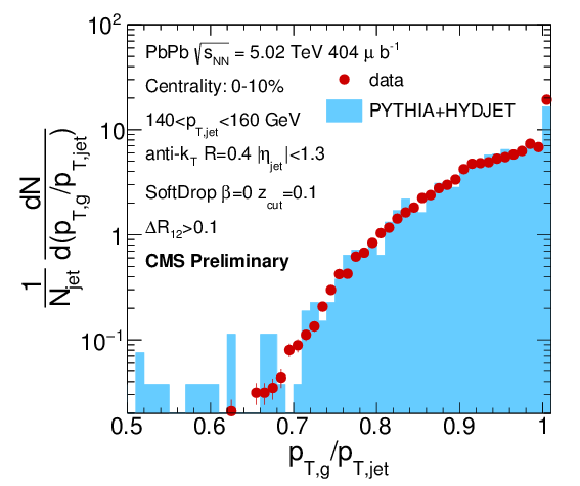
png pdf |
Figure 1-b:
Groomed jet energy fraction in pp (a) and 10% most central PbPb collisions (b) for jets with 140 $ < {p_{\mathrm {T,jet}}}< $ 160 GeV and $|\eta _{\mathrm {jet}}|< $ 1.3. The pp data is compared to the PYTHIA event generator and the PbPb data to PYTHIA embedded into the HYDJET event generator. Jets are reconstructed with the anti- ${k_{\mathrm {T}}}$ algorithm and groomed using Softdrop. The jets are selected based on the ungroomed transverse momentum. |
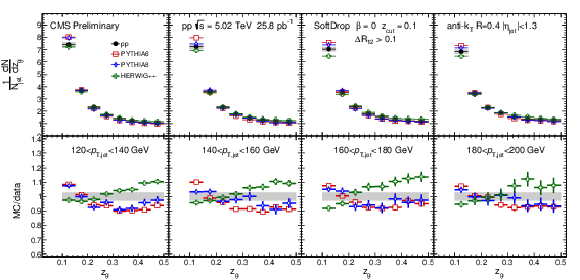
png pdf |
Figure 2:
Splitting function in pp collisions for several jet ${p_{\mathrm {T}}} $ intervals ranging between $ {p_{\mathrm {T,jet}}}= $ 120 GeV and $ {p_{\mathrm {T,jet}}}= $ 200 GeV compared to PYTHIA and HERWIG event generators. The shaded area indicates the systematic uncertainty on the measurement while the vertical lines represent the statistical uncertainty. |
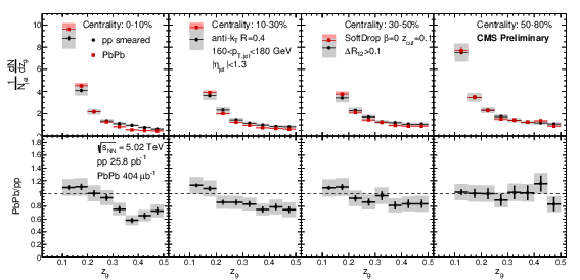
png pdf |
Figure 3:
Splitting function in PbPb for 160 $ |
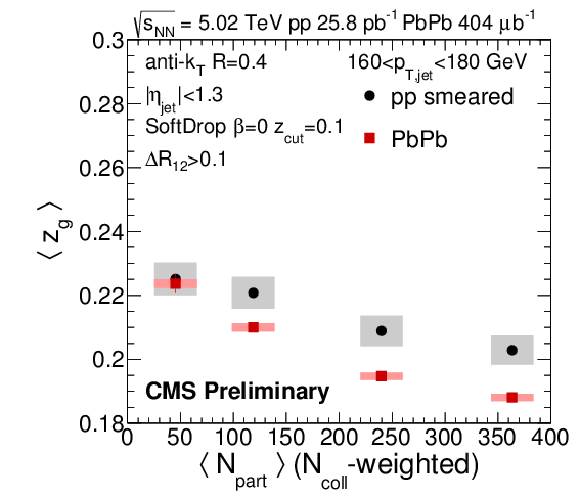
png pdf |
Figure 4-a:
Mean ${z_{\mathrm {g}}}$ in PbPb and smeared pp collisions as function of the average number of participants for two different jet ${p_{\mathrm {T}}} $ selections. The vertical error bars indicate the statistical uncertainty while the shaded area corresponds to the systematic uncertainty. |
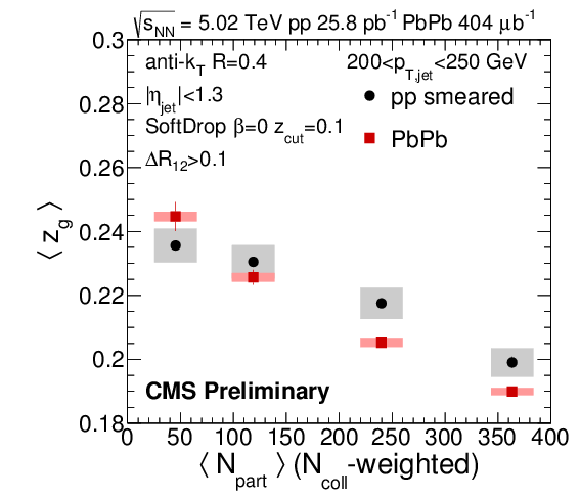
png pdf |
Figure 4-b:
Mean ${z_{\mathrm {g}}}$ in PbPb and smeared pp collisions as function of the average number of participants for two different jet ${p_{\mathrm {T}}} $ selections. The vertical error bars indicate the statistical uncertainty while the shaded area corresponds to the systematic uncertainty. |
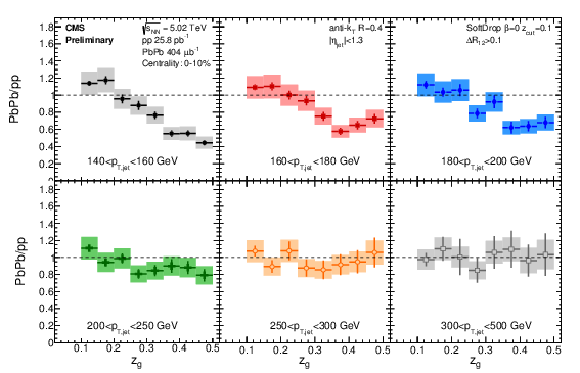
png pdf |
Figure 5:
Ratio of splitting function in PbPb and smeared pp collisions in 10% most central events for several ${p_{\mathrm {T,jet}}}$ ranges. The shaded area indicates the systematic uncertainty on the measurement while the vertical lines represent the statistical uncertainty. |
| Tables | |
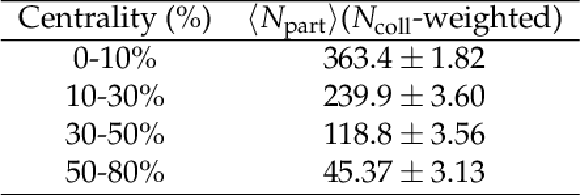
png pdf |
Table 1:
Centrality ranges with corresponding average number of participants (scaled by $N_{\mathrm {coll}}$) used in the analysis. The uncertainty on $< N_{\mathrm {part}}> $ originates from parameters used in the Glauber model. |
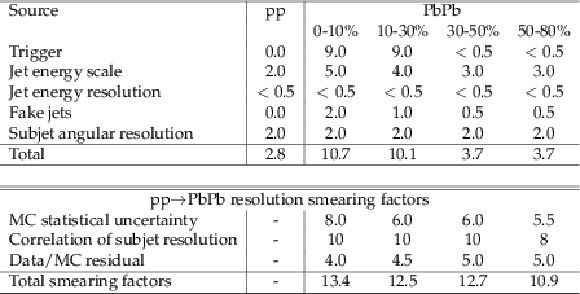
png pdf |
Table 2:
Summary of individual contributions in percentiles to the systematic uncertainty of the ${z_{\mathrm {g}}}$ distributions. The maximum uncertainty along ${z_{\mathrm {g}}}$ is reported. The uncertainties on the smearing factors apply to the pp measurement smeared with the resolution difference between PbPb and pp for a given centrality selection. |
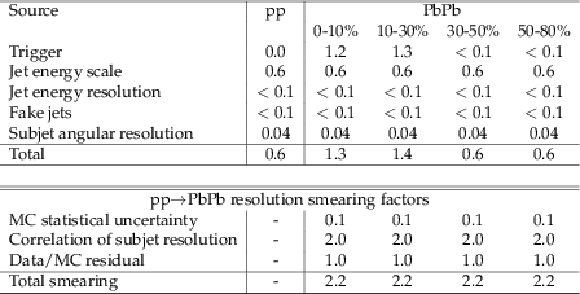
png pdf |
Table 3:
Summary of individual contributions in percentiles to the systematic uncertainty of the mean ${z_{\mathrm {g}}}$. The uncertainties on the smearing factors apply to the pp measurement smeared with the resolution difference between PbPb and pp for a given centrality selection. |
| Summary |
| A measurement of the generalized fragmentation function, also referred to as 'Splitting Function', in pp and PbPb collisions at a center of mass energy of $5.02$ TeV per nucleon pair has been presented. Both the PYTHIA and HERWIG++ event generator agree with the measured splitting function in pp collisions at the level of 10%. This agreement is also observed in peripheral PbPb collisions. In central PbPb collisions, a significantly steeper slope for the splitting function is observed indicating that the splitting process of a parton traversing the hot medium created in heavy ion collisions is modified. |
| Additional Figures | |
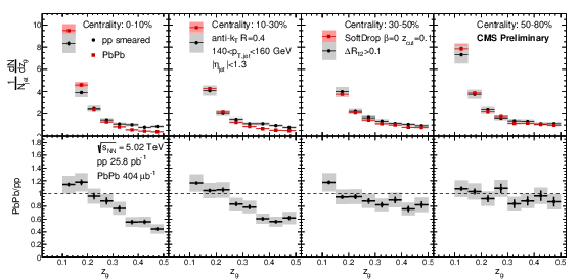
png pdf |
Additional Figure 1:
Splitting function in PbPb for 140 $ < p_{\mathrm{T,\,jet}}< $ 160 GeV in several centrality ranges compared to pp data. For this comparison the resolution of the pp data is deteriorated to the same resolution as the PbPb measurement for each centrality selection. The shaded area around the data points indicates the systematic uncertainty while the vertical lines represent the statistical uncertainty. |
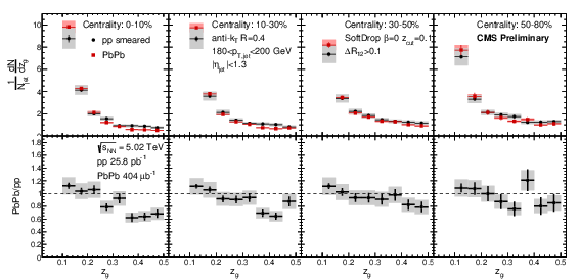
png pdf |
Additional Figure 2:
Splitting function in PbPb for 180 $ < p_{\mathrm{T,\,jet}}< $ 200 GeV in several centrality ranges compared to pp data. For this comparison the resolution of the pp data is deteriorated to the same resolution as the PbPb measurement for each centrality selection. The shaded area around the data points indicates the systematic uncertainty while the vertical lines represent the statistical uncertainty. |
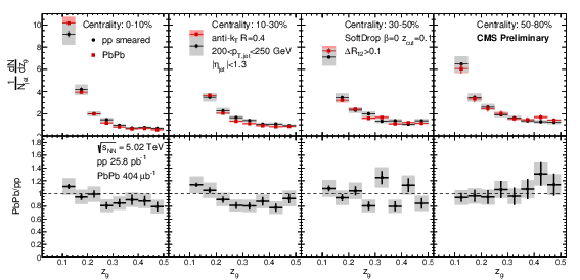
png pdf |
Additional Figure 3:
Splitting function in PbPb for 200 $ < p_{\mathrm{T,\,jet}}< $ 250 GeV in several centrality ranges compared to pp data. For this comparison the resolution of the pp data is deteriorated to the same resolution as the PbPb measurement for each centrality selection. The shaded area around the data points indicates the systematic uncertainty while the vertical lines represent the statistical uncertainty. |

png pdf |
Additional Figure 4:
Mean $z_{\mathrm {g}}$ in PbPb and smeared pp collisions as function of the average number of participants for 140 $ < p_{\mathrm{T,\,jet}}< $ 160 GeV. The vertical error bars indicate the statistical uncertainty while the shaded area corresponds to the systematic uncertainty. |
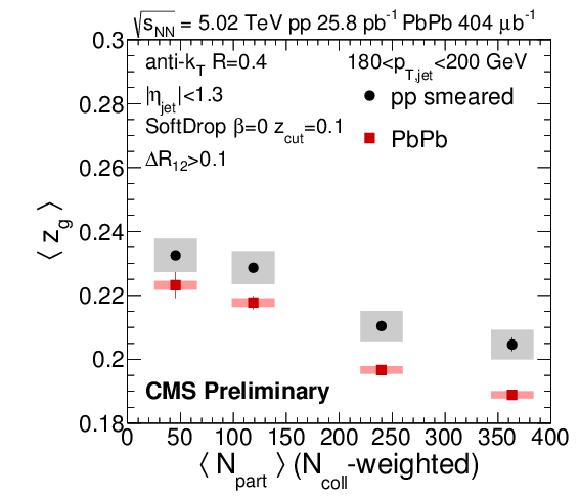
png pdf |
Additional Figure 5:
Mean $z_{\mathrm {g}}$ in PbPb and smeared pp collisions as function of the average number of participants for 180 $ < p_{\mathrm{T,\,jet}}< $ 200 GeV. The vertical error bars indicate the statistical uncertainty while the shaded area corresponds to the systematic uncertainty. |
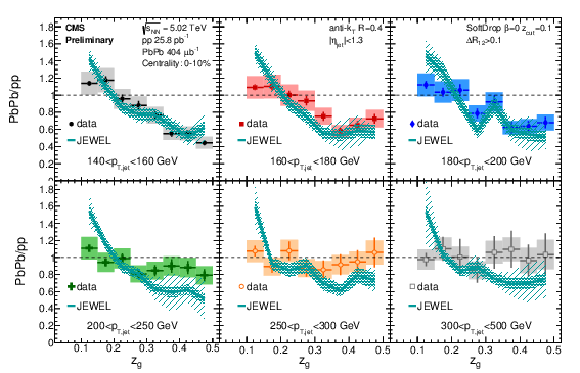
png pdf |
Additional Figure 6:
Ratio of splitting function in PbPb and smeared pp collisions in 10% most central events for several ${p_{\mathrm{T,\,jet}}}$ ranges. The shaded area indicates the systematic uncertainty on the measurement while the vertical lines represent the statistical uncertainty. The measurement is compared to predictions of the jet quenching event generator JEWEL. |

png pdf |
Additional Figure 7:
Ratio of splitting function in PbPb and smeared pp collisions for various centrality selection and 160 $ < {p_{\mathrm{T,\,jet}}} < $ 180 GeV. The measurement is compared to the jet quenching event generator JEWEL. |
| References | ||||
| 1 | M. Gyulassy and M. Plumer | Jet Quenching in Dense Matter | Phys.Lett.B 243 (1990) 432--438 | |
| 2 | R. Baier, Y. L. Dokshitzer, S. Peigne, and D. Schiff | Induced gluon radiation in a QCD medium | Phys.Lett.B 345 (1995) 277--286 | hep-ph/9411409 |
| 3 | PHENIX Collaboration | Suppression of hadrons with large transverse momentum in central Au+Au collisions at $ \sqrt{s_{NN}} $ = 130-GeV | Phys.Rev.Lett. 88 (2002) 022301 | nucl-ex/0109003 |
| 4 | PHENIX Collaboration | Suppressed $ \pi^{0} $ production at large transverse momentum in central Au+ Au collisions at $ \sqrt{s_{NN}} $ = 200 GeV | Phys.Rev.Lett. 91 (2003) 072301 | nucl-ex/0304022 |
| 5 | STAR Collaboration | Transverse momentum and collision energy dependence of high $ p_{T} $ hadron suppression in Au+Au collisions at ultrarelativistic energies | Phys.Rev.Lett. 91 (2003) 172302 | nucl-ex/0305015 |
| 6 | BRAHMS Collaboration | Transverse momentum spectra in Au+Au and d+Au collisions at $ \sqrt{s_{NN}} $ = 200 GeV and the pseudorapidity dependence of high $ p_{T} $ suppression | Phys.Rev.Lett. 91 (2003) 072305 | nucl-ex/0307003 |
| 7 | PHOBOS Collaboration | Charged hadron transverse momentum distributions in Au + Au collisions at $ \sqrt{s_{NN}} $ = 200 GeV | Phys.Lett.B 578 (2004) 297--303 | nucl-ex/0302015 |
| 8 | ALICE Collaboration | Suppression of Charged Particle Production at Large Transverse Momentum in Central Pb--Pb Collisions at $ \sqrt{s_{NN}} = 2.76 $ TeV | Phys.Lett.B 696 (2011) 30--39 | 1012.1004 |
| 9 | ALICE Collaboration | Particle-yield modification in jet-like azimuthal di-hadron correlations in Pb-Pb collisions at $ \sqrt{s_{NN}} = 2.76 $ TeV | Phys.Rev.Lett. 108 (2012) 092301 | 1110.0121 |
| 10 | ATLAS Collaboration | Measurement of charged-particle spectra in Pb+Pb collisions at $ \sqrt{{s}_\mathsf{{NN}}} = 2.76 $ TeV with the ATLAS detector at the LHC | 1504.04337 | |
| 11 | CMS Collaboration | Study of high-pT charged particle suppression in PbPb compared to $ pp $ collisions at $ \sqrt{s_{NN}}=2.76 $ TeV | Eur.Phys.J.C 72 (2012) 1945 | CMS-HIN-10-005 1202.2554 |
| 12 | ATLAS Collaboration | Observation of a Centrality-Dependent Dijet Asymmetry in Lead-Lead Collisions at $ \sqrt{s_{NN}} $= 2.76 TeV with the ATLAS Detector at the LHC | Phys.Rev.Lett. 105 (2010) 252303 | 1011.6182 |
| 13 | CMS Collaboration | Jet momentum dependence of jet quenching in PbPb collisions at $ \sqrt{s_{NN}}=2.76 $ TeV | Phys.Lett.B 712 (2012) 176--197 | CMS-HIN-11-013 1202.5022 |
| 14 | ATLAS Collaboration | Measurement of the jet radius and transverse momentum dependence of inclusive jet suppression in lead-lead collisions at $ \sqrt{s_{NN}}=2.76 $ TeV with the ATLAS detector | Phys.Lett.B 719 (2013) 220--241 | 1208.1967 |
| 15 | ALICE Collaboration | Measurement of charged jet suppression in Pb-Pb collisions at $ \sqrt{s_{NN}} $ = 2.76 TeV | JHEP 1403 (2014) 013 | 1311.0633 |
| 16 | ALICE Collaboration | Measurement of jet suppression in central Pb-Pb collisions at $ \sqrt{s_{\rm NN}} $ = 2.76 TeV | Phys.Lett.B 746 (2015) 1--14 | 1502.01689 |
| 17 | CMS Collaboration | Measurement of jet fragmentation in PbPb and pp collisions at $ \sqrt{s_{NN}}=2.76 $ TeV | Phys.Rev.C 90 (2014), no. 2, 024908 | CMS-HIN-12-013 1406.0932 |
| 18 | CMS Collaboration | Modification of jet shapes in PbPb collisions at $ \sqrt {s_{NN}} = 2.76 $ TeV | Phys.Lett.B 730 (2014) 243--263 | CMS-HIN-12-002 1310.0878 |
| 19 | I. Vitev | Large angle hadron correlations from medium-induced gluon radiation | Phys.Lett.B 630 (2005) 78--84 | hep-ph/0501255 |
| 20 | T. Renk | A Comparison study of medium-modified QCD shower evolution scenarios | Phys.Rev.C 79 (2009) 054906 | 0901.2818 |
| 21 | T. Renk | YaJEM: a Monte Carlo code for in-medium shower evolution | Int.J.Mod.Phys.E 20 (2011) 1594--1599 | 1009.3740 |
| 22 | N. Armesto et al. | Comparison of jet quenching formalisms for a quark-gluon plasma ``brick'' | Phys.Rev.C 86 (Dec, 2012) 064904 | |
| 23 | A. Majumder and J. Putschke | Mass depletion: a new parameter for quantitative jet modification | Phys.Rev.C 93 (2016), no. 5, 054909 | 1408.3403 |
| 24 | S. D. Ellis, C. K. Vermilion, and J. R. Walsh | Recombination Algorithms and Jet Substructure: Pruning as a Tool for Heavy Particle Searches | Phys.Rev.D 81 (2010) 094023 | 0912.0033 |
| 25 | J. M. Butterworth, A. R. Davison, M. Rubin, and G. P. Salam | Jet substructure as a new Higgs search channel at the LHC | Phys.Rev.Lett. 100 (2008) 242001 | 0802.2470 |
| 26 | D. Krohn, J. Thaler, and L.-T. Wang | Jet Trimming | JHEP 02 (2010) 084 | 0912.1342 |
| 27 | M. Dasgupta, A. Fregoso, S. Marzani, and G. P. Salam | Towards an understanding of jet substructure | JHEP 09 (2013) 029 | 1307.0007 |
| 28 | A. J. Larkoski, S. Marzani, G. Soyez, and J. Thaler | Soft Drop | JHEP 05 (2014) 146 | 1402.2657 |
| 29 | A. J. Larkoski, S. Marzani, and J. Thaler | Sudakov Safety in Perturbative QCD | Phys.Rev.D 91 (2015), no. 11, 111501 | 1502.01719 |
| 30 | Y. Mehtar-Tani and K. Tywoniuk | Jet (de)coherence in Pb–Pb collisions at the LHC | Phys.Lett.B 744 (2015) 284--287 | 1401.8293 |
| 31 | J. Casalderrey-Solana, Y. Mehtar-Tani, C. A. Salgado, and K. Tywoniuk | New picture of jet quenching dictated by color coherence | Phys.Lett.B 725 (2013) 357--360 | 1210.7765 |
| 32 | CMS Collaboration | The CMS experiment at the CERN LHC | JINST 3 (2008) S08004 | CMS-00-001 |
| 33 | CMS Collaboration | Particle-Flow Event Reconstruction in CMS and Performance for Jets, Taus, and $ E_{\mathrm{T}}^{\text{miss}} $ | CDS | |
| 34 | CMS Collaboration | Commissioning of the Particle-flow Event Reconstruction with the first LHC collisions recorded in the CMS detector | CDS | |
| 35 | M. Cacciari, G. P. Salam, and G. Soyez | FastJet user manual | 1111.6097 | |
| 36 | M. Cacciari and G. P. Salam | Dispelling the $ N^3 $ myth for the Kt jet-finder | Phys.Lett.B 641 (2006) 57--61 | hep-ph/0512210 |
| 37 | M. L. Miller, K. Reygers, S. J. Sanders, and P. Steinberg | Glauber modeling in high energy nuclear collisions | Ann. Rev. Nucl. Part. Sci. 57 (2007) 205--243 | nucl-ex/0701025 |
| 38 | CMS Collaboration | Observation and studies of jet quenching in PbPb collisions at nucleon-nucleon center-of-mass energy = 2.76 TeV | Phys.Rev.C 84 (2011) 024906 | CMS-HIN-10-004 1102.1957 |
| 39 | T. Sj\"ostrand, S. Mrenna, and P. Skands | PYTHIA 6.4 physics and manual | JHEP 05 (2006) 026 | hep-ph/0603175 |
| 40 | R. Field | Early LHC Underlying Event Data - Findings and Surprises | in Hadron collider physics. Proceedings, 22nd Conference, HCP 2010, Toronto, Canada, August 23-27, 2010 2010 | 1010.3558 |
| 41 | I. P. Lokhtin and A. M. Snigirev | A Model of jet quenching in ultrarelativistic heavy ion collisions and high-p(T) hadron spectra at RHIC | Eur.Phys.J.C 45 (2006) 211--217 | hep-ph/0506189 |
| 42 | GEANT4 Collaboration | GEANT-4 --- a simulation toolkit | NIMA 506 (2003) 250 | |
| 43 | T. Sjostrand, S. Mrenna, and P. Z. Skands | A Brief Introduction to PYTHIA 8.1 | CPC 178 (2008) 852--867 | 0710.3820 |
| 44 | CMS Collaboration | Event generator tunes obtained from underlying event and multiparton scattering measurements | Eur.Phys.J.C 76 (2016), no. 3, 155 | CMS-GEN-14-001 1512.00815 |
| 45 | M. Bahr et al. | Herwig++ Physics and Manual | Eur.Phys.J.C 58 (2008) 639--707 | 0803.0883 |
| 46 | M. H. Seymour and A. Siodmok | Constraining MPI models using $ \sigma_{eff} $ and recent Tevatron and LHC Underlying Event data | JHEP 10 (2013) 113 | 1307.5015 |
| 47 | P. Berta, M. Spousta, D. W. Miller, and R. Leitner | Particle-level pileup subtraction for jets and jet shapes | JHEP 1406 (2014) 092 | 1403.3108 |
| 48 | G. Soyez et al. | Pileup subtraction for jet shapes | Phys.Rev.Lett. 110 (2013), no. 16, 162001 | 1211.2811 |
| 49 | CMS Collaboration | Determination of Jet Energy Calibration and Transverse Momentum Resolution in CMS | JINST 6 (2011) P11002 | CMS-JME-10-011 1107.4277 |
| 50 | Y. L. Dokshitzer, G. D. Leder, S. Moretti, and B. R. Webber | Better jet clustering algorithms | JHEP 08 (1997) 001 | hep-ph/9707323 |

|
Compact Muon Solenoid LHC, CERN |

|

|

|

|

|

|